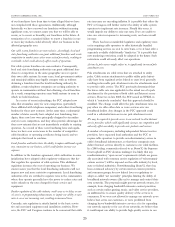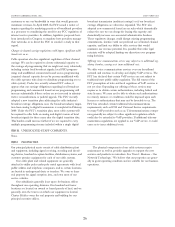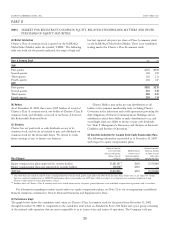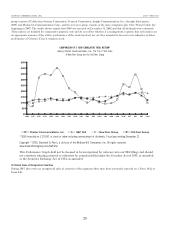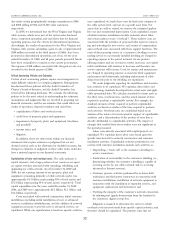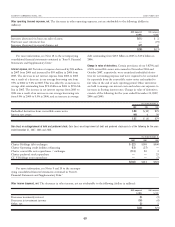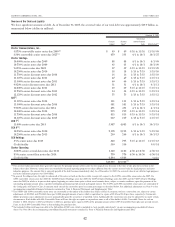Charter 2007 Annual Report Download - page 43
Download and view the complete annual report
Please find page 43 of the 2007 Charter annual report below. You can navigate through the pages in the report by either clicking on the pages listed below, or by using the keyword search tool below to find specific information within the annual report.
also made certain geographically strategic acquisitions in 2006
and 2007 adding 17,600 and 25,500 video customers,
respectively.
In 2006, we determined that the West Virginia and Virginia
cable systems, which were part of the system sales disclosed
above, comprised operations and cash flows that for financial
reporting purposes met the criteria for discontinued operations.
Accordingly, the results of operations for the West Virginia and
Virginia cable systems (including a gain on sale of approximately
$200 million recorded in the third quarter of 2006), have been
presented as discontinued operations, net of tax, for the year
ended December 31, 2006, and all prior periods presented herein
have been reclassified to conform to the current presentation.
Tax expense of $18 million associated with this gain on sale was
recorded in the fourth quarter of 2006.
Critical Accounting Policies and Estimates
Certain of our accounting policies require our management to
make difficult, subjective or complex judgments. Management
has discussed these policies with the Audit Committee of
Charter’s board of directors, and the Audit Committee has
reviewed the following disclosure. We consider the following
policies to be the most critical in understanding the estimates,
assumptions and judgments that are involved in preparing our
financial statements, and the uncertainties that could affect our
results of operations, financial condition and cash flows:
kcapitalization of labor and overhead costs;
kuseful lives of property, plant and equipment;
kimpairment of property, plant, and equipment, franchises,
and goodwill;
kincome taxes; and
klitigation.
In addition, there are other items within our financial
statements that require estimates or judgment but are not
deemed critical, such as the allowance for doubtful accounts, but
changes in estimates or judgment in these other items could also
have a material impact on our financial statements.
Capitalization of labor and overhead costs. The cable industry is
capital intensive, and a large portion of our resources are spent
on capital activities associated with extending, rebuilding, and
upgrading our cable network. As of December 31, 2007 and
2006, the net carrying amount of our property, plant and
equipment (consisting primarily of cable network assets) was
approximately $5.1 billion (representing 35% of total assets) and
$5.2 billion (representing 35% of total assets), respectively. Total
capital expenditures for the years ended December 31, 2007,
2006, and 2005 were approximately $1.2 billion, $1.1 billion, and
$1.1 billion, respectively.
Costs associated with network construction, initial customer
installations (including initial installations of new or advanced
services), installation refurbishments, and the addition of network
equipment necessary to provide new or advanced services, are
capitalized. While our capitalization is based on specific activities,
once capitalized, we track these costs by fixed asset category at
the cable system level, and not on a specific asset basis. For
assets that are sold or retired, we remove the estimated applica-
ble cost and accumulated depreciation. Costs capitalized as part
of initial customer installations include materials, direct labor,
and certain indirect costs (“overhead”). These indirect costs are
associated with the activities of personnel who assist in connect-
ing and activating the new service, and consist of compensation
and overhead costs associated with these support functions. The
costs of disconnecting service at a customer’s dwelling or recon-
necting service to a previously installed dwelling are charged to
operating expense in the period incurred. As our product
offerings mature and our reconnect activity increases, our capital-
izable installations will continue to decrease and therefore our
service expenses will increase. Costs for repairs and maintenance
are charged to operating expense as incurred, while equipment
replacement and betterments, including replacement of cable
drops from the pole to the dwelling, are capitalized.
We make judgments regarding the installation and construc-
tion activities to be capitalized. We capitalize direct labor and
overhead using standards developed from actual costs and appli-
cable operational data. We calculate standards for items such as
the labor rates, overhead rates, and the actual amount of time
required to perform a capitalizable activity. For example, the
standard amounts of time required to perform capitalizable
activities are based on studies of the time required to perform
such activities. Overhead rates are established based on an
analysis of the nature of costs incurred in support of capitalizable
activities, and a determination of the portion of costs that is
directly attributable to capitalizable activities. The impact of
changes that resulted from these studies were not significant in
the periods presented.
Labor costs directly associated with capital projects are
capitalized. We capitalize direct labor costs based upon the
specific time devoted to network construction and customer
installation activities. Capitalizable activities performed in con-
nection with customer installations include such activities as:
kDispatching a “truck roll” to the customer’s dwelling for
service connection;
kVerification of serviceability to the customer’s dwelling (i.e.,
determining whether the customer’s dwelling is capable of
receiving service by our cable network and/or receiving
advanced or Internet services);
kCustomer premise activities performed by in-house field
technicians and third-party contractors in connection with
customer installations, installation of network equipment in
connection with the installation of expanded services, and
equipment replacement and betterment; and
kVerifying the integrity of the customer’s network connection
by initiating test signals downstream from the headend to
the customer’s digital set-top box.
Judgment is required to determine the extent to which
overhead costs incurred result from specific capital activities, and
therefore should be capitalized. The primary costs that are
CHARTER COMMUNICATIONS, INC. 2007 FORM 10-K
32





